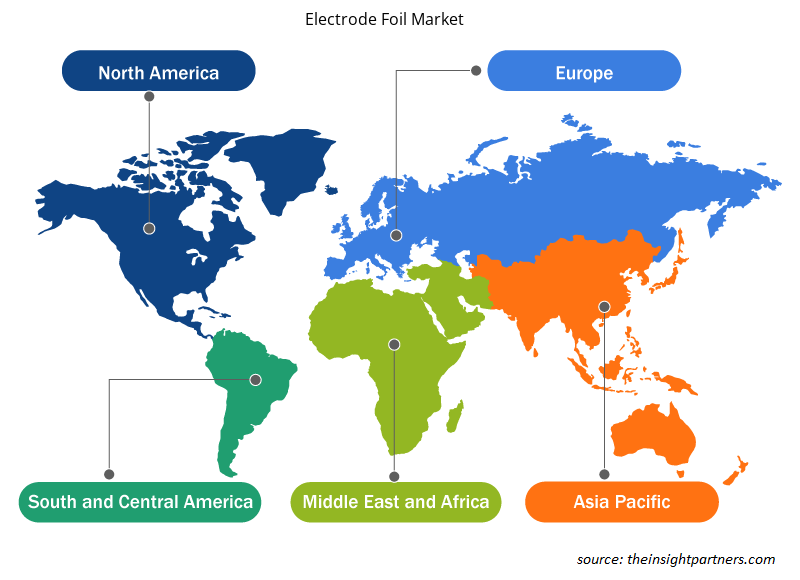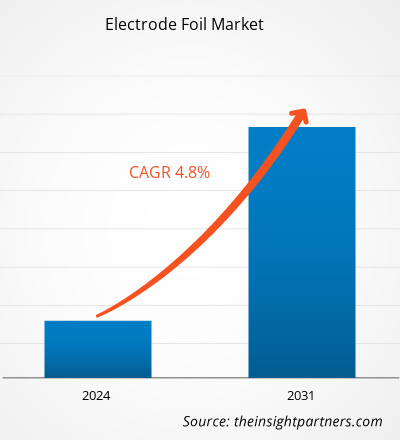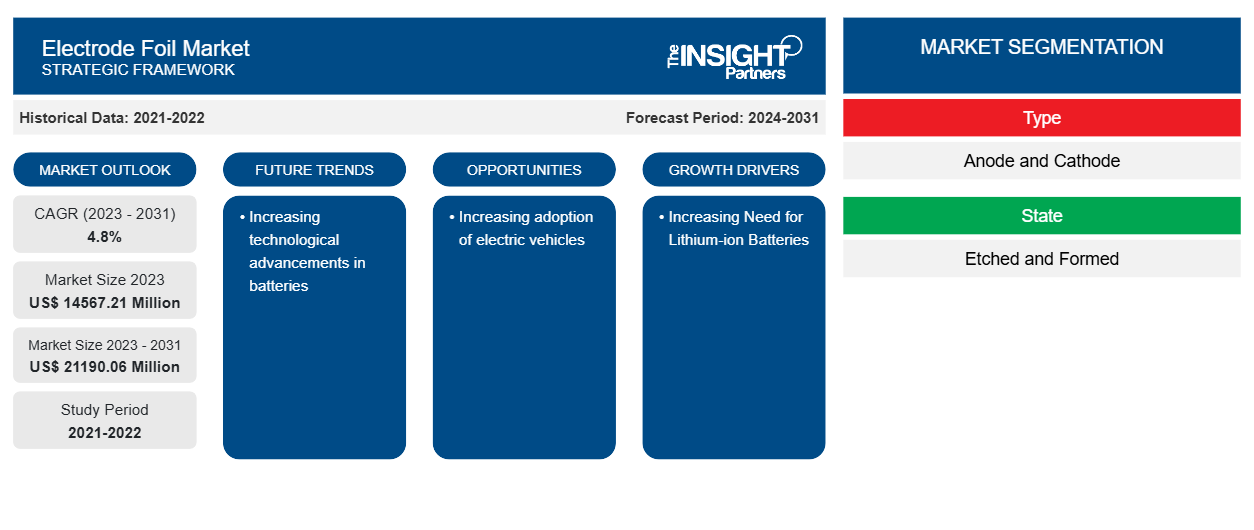Der Markt für Elektrodenfolien soll von 14.567,21 Millionen US-Dollar im Jahr 2023 auf 21.190,06 Millionen US-Dollar im Jahr 2031 anwachsen. Der Markt soll zwischen 2023 und 2031 eine durchschnittliche jährliche Wachstumsrate (CAGR) von 4,8 % verzeichnen. Der zunehmende technologische Fortschritt bei Batterien dürfte ein wichtiger Trend auf dem Markt bleiben.
Elektrodenfolie Marktanalyse
Mit steigendem Bedarf an Speicherkapazität und Rechenleistung werden elektronische Systeme immer kleiner und dünner. Die Entwicklung elektronischer Komponenten unterliegt aufgrund der Anforderungen an Energieerzeugung, Downsizing, Hochgeschwindigkeitsdatenübertragung und zunehmende Übertragungs- und Speicherkapazität erheblichen Veränderungen. Elektrodenfolien werden häufig bei der Herstellung anspruchsvoller elektronischer Komponenten verwendet. Eine Elektrodenfolie ist typischerweise mit Keramik- und Metallpartikeln beschichtet und besteht aus Kupfer, Aluminium oder Nickel. Um die Größe des Kondensators zu verringern und die Ausgangsentladung zu steigern, werden diese Folien als Stromelektroden in den entsprechenden Elektrolytkondensatoren verwendet. Elektrolytkondensatoren werden für viele Anwendungen benötigt, beispielsweise für Netzteile und Motherboards für Computer, bei denen winzige Volumenpakete mit hoher Kapazität und geringem Widerstand erforderlich sind.
Elektrodenfolie Marktübersicht
Elektrodenfolie verbessert die Leistung der Batterie und bietet Vorteile wie höhere Energiedichte, bessere Haftung, Korrosionsschutz, längere Lebensdauer und geringere Gesamtbetriebskosten. Darüber hinaus ermöglicht die Verwendung von galvanisch abgeschiedener Kupferfolie Anpassungsoptionen wie unterschiedliche Abziehfestigkeiten oder Haftungsgrade je nach Anwendungsbedarf. Durch die Anpassung dieser Eigenschaften können elektronische Geräte optimal funktionieren und gleichzeitig die Signalintegrität bei höheren Frequenzen aufrechterhalten.Foilimproves the battery’s performance, and it offers benefits such as higher energy density, better adhesion, corrosion protection, longer cycle life and lower total cost of ownership. Moreover, electrode-posited copper foil equipment allows for customization options like different peel strengths or adhesion levels depending on application needs. By tailoring these properties, electronic devices can function optimally while maintaining signal integrity at higher frequencies.
Passen Sie diesen Bericht Ihren Anforderungen an
Sie erhalten kostenlos individuelle Anpassungen an jedem Bericht, einschließlich Teilen dieses Berichts oder einer Analyse auf Länderebene, eines Excel-Datenpakets sowie tolle Angebote und Rabatte für Start-ups und Universitäten.
-
Holen Sie sich die wichtigsten Markttrends aus diesem Bericht.Dieses KOSTENLOSE Beispiel umfasst eine Datenanalyse von Markttrends bis hin zu Schätzungen und Prognosen.
.
Treiber und Chancen auf dem Elektrodenfolienmarkt
Steigender Bedarf an Lithium-Ionen-Batterien
Die Nachfrage nach Lithium-Ionen-Batterien steigt weltweit deutlich an. Lithium-Ionen-Batterien werden häufig in Computern, Mobilgeräten, Energiespeichersystemen, Notstromversorgungen, unterbrechungsfreien Stromversorgungen, Unterhaltungselektronik und Elektrofahrzeugen verwendet. Bis 2030 wird Chinas Bedarf an Lithium-Ionen-Batterien für Elektrofahrzeuge voraussichtlich etwa 700 GWh betragen. Bis 2030 wird dieser hohe Bedarf etwa die Hälfte des weltweiten Bedarfs an Lithium-Ionen-Batterien für Elektrofahrzeuge ausmachen. Darüber hinaus wird erwartet, dass die Nachfrage nach Tablets, PCs und anderen Unterhaltungselektronikprodukten in den kommenden Jahren aufgrund des steigenden verfügbaren Einkommens in vielen Entwicklungsländern im asiatisch-pazifischen Raum steigen wird. Daher wächst die Nachfrage nach Nickel, Kupfer und gewalzten Kupferlegierungen mit dem Wachstum der Unterhaltungselektronik- und Automobilbranche. Daher wird erwartet, dass die wachsenden Investitionen in den Sektor der Lithium-Ionen-Batterien und der steigende Bedarf an unterbrechungsfreien Stromversorgungen im Fertigungssektor den globalen Markt für Elektrodenfolien positiv beeinflussen werden.GWh. By 2030, this high requirement will account for about half of the world's need for lithium-ion batteries for electric vehicles. Additionally, the demand for tablets, PCs, and other consumer electronics is anticipated to climb in the upcoming years due to the growing disposable income in many developing Asia Pacific countries. Thus, the demand for nickel, copper, and rolled copper alloy is growing with the growing consumer electronics and automotive sectors. Hence, the growing investment in the lithium-ion batteries sector and increasing requirement for uninterruptable power supplies in the manufacturing sector are anticipated to positively impact the global electrode foil market.
Zunehmende Verbreitung von Elektrofahrzeugen
Nach Angaben der Europäischen Kommission beschäftigt die Automobilindustrie 13,8 Millionen Europäer, was 15,1 % der gesamten europäischen Beschäftigung entspricht. Große Marktteilnehmer wie Finolex Cables, Furukawa Electric Co Ltd, Hitachi Ltd, Nexans, NKT Cables, Sumitomo Electric Industries Ltd, Synergy Cables Ltd und andere bringen in diesen Regionen Fahrzeuge auf den Markt. So kündigte Amazon im Juli 2023 seinen Plan an, im Laufe der kommenden Wochen seine ersten europäischen Transporter des US-amerikanischen Elektroautoherstellers Rivian in Deutschland einzusetzen, als Teil der langfristigen Pläne zur Elektrifizierung seines Transportnetzwerks. Im Rahmen einer 2019 von Rivian getätigten Bestellung von 100.000 Fahrzeugen werden in den Regionen München, Berlin und Düsseldorf fast 300 Elektrotransporter auf den Markt kommen. Ebenso brachte MG4 im September 2022 ein neues innovatives Elektroauto in Europa auf den Markt. Außerdem brachte Toyota Motor Corp im Mai 2022 sein erstes in Serie produziertes batteriebetriebenes Elektroauto in Japan auf den Markt. Die zunehmende Verbreitung von Elektrofahrzeugen schafft also weitere Chancen für den Markt.Finolex Cables, Furukawa Electric Co Ltd, Hitachi Ltd, Nexans, NKT Cables, Sumitomo Electric Industries Ltd, Synergy Cables Ltd, and more, are launching vehicles in these regions. For instance, in July 2023, Amazon announced its plan to deploy its first European vans from Rivian, the US-based EV maker, to Germany over the coming weeks as part of long-term plans to electrify its transportation network. As part of a 100,000-vehicle order made in 2019 from Rivian, nearly 300 electric vans will be launched in the Munich, Berlin, and Dusseldorf areas. Similarly, in September 2022, MG4 launched a new innovative electric car in Europe. Also, in May 2022, Toyota Motor Corp launched its first mass-produced battery-electric car in Japan. Thus, the increasing adoption of
Segmentierungsanalyse des Elektrodenfolienmarktberichts
Wichtige Segmente, die zur Ableitung der Marktanalyse für Elektrodenfolien beigetragen haben, sind Typ, Zustand, Material, Bereich und Anwendung.
- Basierend auf dem Typ ist der Elektrodenfolienmarkt in Anode und Kathode unterteilt. Das Segment Lösungen hatte im Jahr 2023 einen größeren Marktanteil.
- Nach Bundesstaaten ist der Markt in geätzte und geformte Segmente unterteilt. Das Cloud-Segment hatte 2023 einen größeren Marktanteil.
- Nach Material ist der Markt in Kupfer und Aluminium segmentiert.
- Nach Material ist der Markt in Niederspannung, Mittelspannung und Hochspannung segmentiert.
- Nach Anwendung ist der Markt in Leiterplatten (PCBs), Festpolymerkondensatoren, Lithium-Ionen-Batterien, Elektrolytkondensatoren und andere unterteilt.PCBs), solid polymer capacitors, lithium-ion batteries, electrolytic capacitors, and others.
Elektrodenfolie Marktanteilsanalyse nach Geografie
Der geografische Umfang des Marktberichts für Elektrodenfolien ist hauptsächlich in fünf Regionen unterteilt: Nordamerika, Asien-Pazifik, Europa, Naher Osten und Afrika sowie Süd- und Mittelamerika.
APAC dominiert den Markt für Elektrodenfolien. Der Markt für Elektrodenfolien in dieser Region wächst aufgrund verschiedener Faktoren, wie zunehmender Regierungsinitiativen sowie der Einführung von Elektrofahrzeugen. So brachte Toyota Motor Corp. im Mai 2022 sein erstes in Serie produziertes batteriebetriebenes Elektroauto in Japan auf den Markt. Daher nimmt die Verwendung von Elektrodenfolien in der APAC-Region zu. dominates the electrode foil market. The electrode foil market in this region is growing due to various factors, such as increasing government initiatives as well as the adoption of electric vehicles. For instance, Also, in May 2022, Toyota Motor Corp launched its first mass-produced battery-electric car in Japan. Therefore, the adoption of electrode foil is increasing in the APAC region.
Regionale Einblicke in den Elektrodenfolienmarkt
Die regionalen Trends und Faktoren, die den Elektrodenfolienmarkt während des Prognosezeitraums beeinflussen, wurden von den Analysten von Insight Partners ausführlich erläutert. In diesem Abschnitt werden auch die Marktsegmente und die Geografie von Elektrodenfolien in Nordamerika, Europa, im asiatisch-pazifischen Raum, im Nahen Osten und Afrika sowie in Süd- und Mittelamerika erörtert.

- Erhalten Sie regionale Daten zum Elektrodenfolienmarkt
Umfang des Marktberichts über Elektrodenfolien
| Berichtsattribut | Details |
|---|---|
| Marktgröße im Jahr 2023 | 14567,21 Millionen US-Dollar |
| Marktgröße bis 2031 | 21190,06 Millionen US-Dollar |
| Globale CAGR (2023 - 2031) | 4,8 % |
| Historische Daten | 2021-2022 |
| Prognosezeitraum | 2024–2031 |
| Abgedeckte Segmente |
Nach Typ
|
| Abgedeckte Regionen und Länder |
Nordamerika
|
| Marktführer und wichtige Unternehmensprofile |
|
Marktteilnehmerdichte: Der Einfluss auf die Geschäftsdynamik
Der Markt für Elektrodenfolien wächst rasant, angetrieben durch die steigende Nachfrage der Endverbraucher aufgrund von Faktoren wie sich entwickelnden Verbraucherpräferenzen, technologischen Fortschritten und einem größeren Bewusstsein für die Vorteile des Produkts. Mit steigender Nachfrage erweitern Unternehmen ihr Angebot, entwickeln Innovationen, um die Bedürfnisse der Verbraucher zu erfüllen, und nutzen neue Trends, was das Marktwachstum weiter ankurbelt.
Die Marktteilnehmerdichte bezieht sich auf die Verteilung der Firmen oder Unternehmen, die in einem bestimmten Markt oder einer bestimmten Branche tätig sind. Sie gibt an, wie viele Wettbewerber (Marktteilnehmer) in einem bestimmten Marktraum im Verhältnis zu seiner Größe oder seinem gesamten Marktwert präsent sind.
Die wichtigsten auf dem Elektrodenfolienmarkt tätigen Unternehmen sind:
- Nippon Chemi-Con Corporation
- Industrie De Nora SpA
- TDK Corporation
- Targray Technology International Inc.
- KDK Corporation
- NICHICON CORPORATION
Haftungsausschluss : Die oben aufgeführten Unternehmen sind nicht in einer bestimmten Reihenfolge aufgeführt.

- Überblick über die wichtigsten Akteure auf dem Elektrodenfolienmarkt
Neuigkeiten und aktuelle Entwicklungen zum Elektrodenfolienmarkt
Der Markt für Elektrodenfolien wird durch die Erhebung qualitativer und quantitativer Daten nach Primär- und Sekundärforschung bewertet, die wichtige Unternehmensveröffentlichungen, Verbandsdaten und Datenbanken umfasst. Nachfolgend sind einige der Entwicklungen auf dem Markt für Elektrodenfolien aufgeführt:
- SiAT, ein führender taiwanesischer Hersteller fortschrittlicher Nanomaterialien für Batterien, freut sich, eine strategische Partnerschaft mit der Taiwan CS Aluminum Corporation (CSAC) bekannt zu geben. Diese Zusammenarbeit markiert die Einführung einer mit Kohlenstoffnanoröhren beschichteten Aluminiumfolie, die der wachsenden Nachfrage nach schnellerem Laden und längerer Lebensdauer von Lithium-Ionen-Batterien, Natriumbatterien und Superkondensatoren gerecht werden soll. (Quelle: SiAT, Pressemitteilung, März 2024.)
- Mitsubishi Electric, ein führender Anbieter von Contact Image Sensoren (CIS), und Koenig & Bauer, ein Pionier für industrielle Druckanwendungen und Inline-Bildverarbeitungssysteme für verschiedene Anwendungen, haben eine Absichtserklärung für ihre künftige Zusammenarbeit unterzeichnet. Die strategische Partnerschaft wird die Stärken beider Unternehmen bündeln, um standardisierte, qualitativ hochwertige Bildverarbeitungskomponenten anzubieten, die darauf abzielen, die Produktion von Elektrodenfolie für Batteriezellen zu optimieren. (Quelle: Mitsubishi Electric, Pressemitteilung, Februar 2024)
Marktbericht zu Elektrodenfolien – Umfang und Ergebnisse
Der Bericht „Marktgröße und Prognose für Elektrodenfolien (2021–2031)“ bietet eine detaillierte Analyse des Marktes, die die folgenden Bereiche abdeckt:
- Elektrodenfolienmarktgröße und -prognose auf globaler, regionaler und Länderebene für alle wichtigen Marktsegmente, die im Rahmen des Berichts abgedeckt sind
- Elektrodenfolienmarkttrends sowie Marktdynamik wie Treiber, Einschränkungen und wichtige Chancen
- Detaillierte PEST/Porters Five Forces- und SWOT-Analyse
- Elektrodenfolienmarktanalyse mit wichtigen Markttrends, globalen und regionalen Rahmenbedingungen, wichtigen Akteuren, Vorschriften und jüngsten Marktentwicklungen
- Branchenlandschaft und Wettbewerbsanalyse, einschließlich Marktkonzentration, Heatmap-Analyse, prominenten Akteuren und aktuellen Entwicklungen auf dem Elektrodenfolienmarkt
- Detaillierte Firmenprofile
- Historische Analyse (2 Jahre), Basisjahr, Prognose (7 Jahre) mit CAGR
- PEST- und SWOT-Analyse
- Marktgröße Wert/Volumen – Global, Regional, Land
- Branchen- und Wettbewerbslandschaft
- Excel-Datensatz
Aktuelle Berichte
Verwandte Berichte
Erfahrungsberichte
Grund zum Kauf
- Fundierte Entscheidungsfindung
- Marktdynamik verstehen
- Wettbewerbsanalyse
- Kundeneinblicke
- Marktprognosen
- Risikominimierung
- Strategische Planung
- Investitionsbegründung
- Identifizierung neuer Märkte
- Verbesserung von Marketingstrategien
- Steigerung der Betriebseffizienz
- Anpassung an regulatorische Trends























 Kostenlose Probe anfordern für - Markt für Elektrodenfolien
Kostenlose Probe anfordern für - Markt für Elektrodenfolien